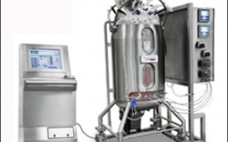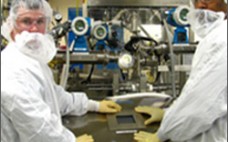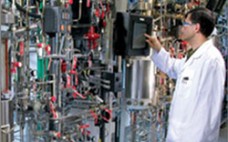Live whole-cell bacterial products have been used as vaccines for many years, and there are currently three such products licensed on the market. Over recent years, however, interest has renewed in this type of product as a delivery system for novel recombinant therapies and vaccines. A number of different organisms have been proposed, such as Escherichia coli and Salmonella species, which might have applicability for such applications. Vaccine applications tend to relate to the potential for low-cost orally delivered products…
Upstream Processing
Implementation of Single-Use Technology in Biopharmaceutical Manufacturing
Single-use filtration systems are increasingly replacing traditional stainless steel filter assemblies, piping, and tanks for purification and storage of bioprocess fluids in biopharmaceutical manufacturing. Unfamiliarity with polymeric materials and the need to ensure patient safety, however, have made extractables and leachables from these new components and systems a primary concern of process developers along with specialists in quality, validation, regulatory affairs, as well as agency reviewers. A general risk-based approach to determination of extractables and leachables from disposable bioprocess equipment…
FlexFactory from Xcellerex – A Proven Biomanufacturing Platform Enabled by Disposables
FlexFactory from Xcellerex is a biomanufacturing platform that is transforming the way the biotechnology industry approaches drug production. Built almost exclusively around disposables technology, each unit operation within the FlexFactory is self-contained in its own controlled environment module (CEM), effectively shrinking the cleanroom around each operation.
In this on-demand webcast, Parrish Galliher, Founder & Chief Technical Officer of Xcellerex, demonstrates how the FlexFactory eliminates the need for expensive clean-room facilities and CIP/SIP infrastructure, resulting in:
• Reduction in Capital Investment by 50% or More
• 70% Reduction in Start-up Time
• 55% Reduction of Carbon Footprint
• Major reduction of Water Consumption
• Increased Flexibility
FlexFactory is the only biomanufacturing platform that delivers the speed and capital efficiency of the CMO approach with the control and long-term economics of company-controlled manufacturing. View this webcast to gain an in-depth understanding of the benefits of this innovative technology.
Follow-on Biologics
This webcast will describe the key steps in developing a CHO culture process for manufacturing a follow-on biologic. Analytical characterization of 14 lots of the commercial product provided information about the range in key product quality attributes of the marketed drug. The scientists at SP-Diosynth have developed a process that yields a product that is analytically comparable to the commercially available molecule. Product quality attributes investigated were aggregation, acidic and basic variants, galactose, sialic acid and fucose content, and complement dependent cytotoxicity activity.
Scalability of the process was demonstrated in 100L stainless steel bioreactors and a 50L single use bioreactor (SUB). The webcast shows SP-Dionsyth’s data indicated that the process generates high titer at scale consistently while achieving product quality similar to the commercial material.
With this on-demand webcast, you will gain valuable insight into aspects of SP-Disoyth’s process development, such as:
• Cell Line Characteristics
• Scalability
• Manufacturability
• Comparability
• Commercializability
The webcast features Sigma S. Mostafa, Ph.D.
Microbial Expression Technology: The New Standard For Protein Expression – Addressing Speed, Quality and Cost of Goods
A new paradigm of microbial strain development has been achieved that overcomes today’s slow, iterative and error-prone process through the use of a novel, streamlined, high throughput platform. The P. fluorescens expression platform, Pfēnex Expression Technology™, reliably delivers host strains expressing large amounts of high quality target protein within very short development times. In this webcast, Dr. Charles H. Squires, Head of Discovery R&D at Pfēnex Inc., discusses:
• An Overview of Pfēnex Expression Technology™
• How Pfēnex Inc. Practices the Technology
• Case Studies Highlighting the Power of the Technology
• Product Areas
• Further Uses of Pfēnex Expression Technology™in Development
Join Dr. Squires as he illustrates how the combination of technologies available through the Pfēnex Expression Technology™system make it the most complete, flexible and productive bacterial strain development and biopharmaceutical production platform available today.
Scaling Up a CHO-Produced Hormone–Protein Fusion Product
Many biotechnology companies recognize the powerful benefits of increasing product titer early in product development as a strategy to minimize manufacturing costs, scale, and the duration necessary to produce clinical supplies and achieve product commercialization. Additional benefits include minimizing or completely avoiding significant regulatory delays to market that can be caused by major process technology changes (such as cell line and product quality changes). Recently, another significant benefit has been realized too: Smaller, more productive and efficient 2,000-L…
Assay Validation for Rapid Detection of Mycoplasma Contamination
Mycoplasmas and related bacteria in the class Mollicutes are parasitic organisms found not only on the external surfaces of a wide range of eukaryotic host cells, but also intracellularly. They are characterized by small size and lack of a rigid cell wall, which gives them resistance to β-lactam antibiotics and the ability to pass through 0.2-µm filters (1,2). Contamination by Mollicutes is a common problem for cell cultures that is not easily detected because it usually does not produce turbidity…
Bridging the Gap from Reusable to Single-Use Manufacturing with Stirred, Single-Use Bioreactors
During the past few years, use of disposable bioreactors in development and manufacturing processes has become widely accepted. Particularly, low–oxygen-demanding cell types such as human and insect cells have proven to be perfectly suitable for cultivation in single-use bag chambers. These bioreactors have significant advantages over their reusable counterparts (1). They transform a single-purpose process using stainless steel reactors into a multipurpose facility in which switching from one application to another is both easy and cost effective. Reusable…
Automated Liquid Handlers As Sources of Error
Use of automated liquid handling equipment for rapid testing and reproducible screening of thousands of molecules, cells, and compounds has become an essential component of life-science laboratories across the globe. Along with an increase in such use, transferred volumes have shrunk, as demands increase on transfer accuracy and precision when aspirating, diluting, dispensing, mixing, and washing. Automated liquid handlers are generally used to increase the productivity and repeatability of volume transfer, but as discussed here, they are still…
Medium and Process Optimization for High Yield, High Density Suspension Cultures: From Low Throughput Spinner Flasks to High Throughput Millilitre Reactors
The most important contributions to high-yield manufacturing processes for the production of recombinant proteins from cultivated mammalian cells have come from the identification of highly enriched and well-balanced media formulations, and fine tuning the process conditions that support high cell culture densities with high specific productivity. The industry standard yield for immunoglobulins or similar molecules derived from suspension-cultivated mammalian cells in bioreactors has risen during the past 20 years from the tens of mg/L to g/L. The more…



